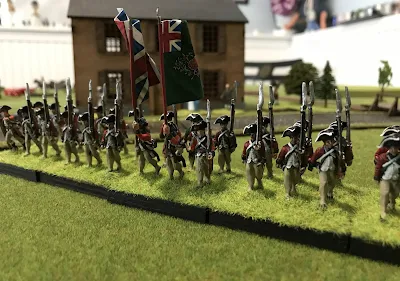For some reason I have never refought any of the classic old school war game scenarios I have so enjoyed reading over the years. Inspired by a recent posting on the Fife and Drum miniatures forum I have decided to jump in and try my hand. But instead of the Seven Years War period I am transporting it to the American Rev War.
The objective of the game is to control the bridge. The river is shallow and can be crossed except 12 inches on each side of the bridge. The house blocks line of sight only. Woods block line of sight and provide cover for troops within it. The hill provides extra range to troops firing from its top. Once a side has lost more then fifty per cent of its troops it must withdraw off the board. Rules used are "The Whites of Their Eyes" by Steve Haller.
Continental Forces:
11th Continental Regiment
9th Continental Regiment
Lee's Legion Dragoons
Rifle Regiment
Hamilton 's Battery (medium gun)
Loyalist Forces:
Volunteers of Ireland
New York Volunteers
British Legion Dragoons
British Legion Infantry
Royal Artillery (medium gun)
Both sides entered the game with a double move distance from their corners. I did this to get into action faster. The Loyalist commander rolled high so would get the first move throughout the game. He decided to send his cavalry towards the bridge supported by the Volunteers of Ireland. The Legion light infantry, New York Volunteers and artillery headed towards the ford opposite the woods.
The Continental Forces took a different track. The Artillery headed straight to the hill to get a dominant position. The rifles headed straight towards the protection of the woods while the line infantry took position on either side of the hill. Let the enemy come to them and destroy them through firepower. Lee's dragoons waited in reserve to be useful.
Fighting occurred by the ford and woods. The Legion Infantry and NYV crossed the river to close with the enemy. Using their superior range the rifles picked away at the legion infantry. (Note: rifles have longer range but can only fire every other turn. Usually a player will fire half his rifles each turn to maintain a constant rate of fire.)
At this point the Loyalist Forces pressed forward to the attack. The British Legion Infantry charged into the woods and after a short sharp fight they drove the riflemen out.
But the Legion cavalry was less successful. They crossed the river, formed line and charged the infantry in front of them. The 11th Continental stood their ground and saw them off with ease. The Legion dragoons charged back as fast as they could. For good measure the 11th fired a volley into the retreating dragoons which put them under 50% and they routed off the table.
Both the 9th Continental and New York Volunteers traded volleys at close range with The Royal Artillery adding their firepower. This was too much form the 9th who failed morale and routed.
In the woods the riflemen passed their morale check and used a split move to get a better shot at the legion infantry. ( In these rules light troops can move part off their movement, fire and then move the remaining portion of their movement. A neat little rule that helps light troops act like light troops.) Close range fire caused the Legion to fail morale and routed back. A staff officer raced to try and rally them which was unsuccessful.
But the damage was done and now the rifles were able to out flank the New York Volunteers. In addition Lee's Legion dragoons formed up facing the Volunteers ready to charge. With the Volunteers of Ireland being slowly reduced by artillery and musket fire things did not look good for the Loyalists. His cavalry and light infantry gone and one of his line regiments reduced the commander ordered his forces to retire to fight another day. Both sides had fought well but the Continental 's had had a better plan. All in all a fun game and one could play in any number of periods. Perhaps the Crimean War next?










































